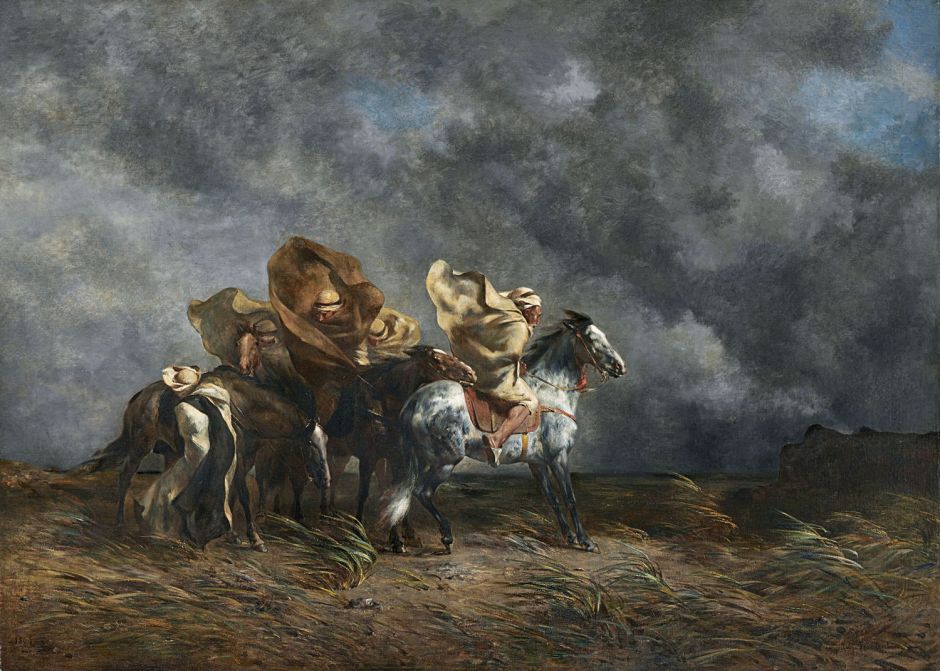Across much of North America, Europe and Asia winter is now in full swing. Where it’s not just bitterly cold, it’s normally cold, wet and muddy. So this weekend I asked my tour guide to take me somewhere the exact opposite. So here we are, in the desert to warm up and dry out.
This weekend’s selection of paintings covers views of different deserts, from the late sixteenth to the early twentieth centuries.
Despite extensive experience in North Africa and the Middle East, most Europeans had never seen a proper desert until the nineteenth century, and artists were no exception.

Jacopo Tintoretto spent his entire career in Venice, yet hadn’t apparently heard accounts of travelling merchants who had visited Palestine or the Middle East. Like other contemporary paintings of Biblical desert scenes, his Temptation of Christ shows Jesus Christ fasting for forty days and nights in the desert of Judea. Ample foreground vegetation and background trees look out of place to the modern eye.

So does Nicolas Poussin’s Israelites Gathering the Manna in the Desert from 1637-9. The ground here is at least more barren, and the rocks wilder, but I’m sure that fine stand of trees is out of place.
Then, with the opening up of opportunities to travel more widely in the nineteenth century, landscape painters started returning with vivid visual accounts of desert.

David Roberts’ painting of the Isle of Graia, Gulf of Akabah (1839), shown here as a lithograph, is unusual for showing camels on the beach. We are used to seeing dogs, horses, donkeys, even cows and sheep, but the ‘ship of the desert’ is not a common sight on the beach. The coastline of the Gulf of Aqaba (or Gulf of Eilat) is on the eastern side of the Sinai Peninsula, and before urbanisation, development, and the advent of tourists, had a wild desert beauty, as shown here.
For affluent northern Europeans the Grand Tour became more extended to take in pilgrimage to the Holy Land. In 1842, the young painter Richard Dadd was invited to be artist-companion to his patron, Sir Thomas Phillips, former mayor of Newport in Wales, for his tour of Europe and the Middle East.

Dadd’s watercolour of a Halt in the Desert (c 1845) is an outstanding landscape view. An unusual and haunting nocturne, it shows Phillips’ party seated around a fire, on the shore of the Dead Sea. Phillips is stood behind the fire, lit by it.
The shores of the Dead Sea were soon attracting other artists, among them Edward Lear, better known today for his nonsense poetry.

Lear first visited what is now Israel when he was living in Rome, in 1858. That year, he painted Masada on the Dead Sea or Sebbeh on the Dead Sea, a breathtaking view of this major historical and archaeological site at sunset. The site had only been identified twenty years earlier, and initial archaeological work didn’t start there for a century after Lear painted this.
No sooner than Jean-Léon Gérôme had been admitted to the Legion of Honour than he too travelled extensively in North Africa and the Middle East.

One of the works resulting from his travels, Egyptian Recruits Crossing the Desert (1857) shows a group of new recruits struggling through desperate conditions in the heat of the desert.

He produced several paintings showing Napoleon in Egypt, including this highly detailed and intricate version of General Bonaparte and his Staff in Egypt (1867). The French Campaign in Egypt and Syria had been in 1798-1801, so this was still relatively recent history, even when viewed from the distance of the final years of the Second Empire.
A few artists were privileged enough to travel with expeditions, and even fewer were unfortunate enough to die on them.

Ludwig Becker was a member of the Burke and Wills Expedition which attempted to be the first to cross the continent of Australia from south (Melbourne) to north in the Gulf of Carpentaria. Like Scott’s ill-fated expedition to the South Pole, this expedition was also part of an unofficial race, against John McDouall Stuart, a South Australian who intended to complete the first south-north crossing of the continent himself.
Becker painted this watercolour view of the Border of the Mud-Desert near Desolation Camp on 9 March 1861, as his health was rapidly deteriorating. He finally died on 29 April 1861, in their camp at Bulloo, from dysentery complicated by scurvy. He completed seventy watercolours, drawings and maps during the expedition, at times going without food and sleep in order to work. Six other members of the expedition also died, including its leader Robert O’Hara Burke.

Eugène Fromentin was a prominent writer, art historian and painter, who was born in La Rochelle, in France, and became one of the first French artists to travel and paint in Algeria. Windstorm on the Esparto Plains of the Sahara from 1864 is one of the later examples of his work from North Africa, which helped establish the vogue for Orientalism, which starts the next and concluding article.

